Most of the information you’re going to find when you look for care guides for bromeliads will correspond to their typical growth uses as an aerial plant, potted plant, or container garden plant. They’re not nearly as commonly grown as a bonsai as say, an acacia bonsai, or fir tree bonsai.
However, these unique plants actually make for a great bonsai, if you’ve got the interest, time, and commitment to care properly for this unique choice.
Let’s take a look at the basic care for, bonsai methods, and propagation for bromeliad bonsai trees and see if they might be a good choice for you.

Bromeliads come in many colors, styles, and sizes.
©Oliver Hoffman/Shutterstock.com
What Makes Bromeliads Good for Bonsai?
Bromeliads are a distinctive and unique choice for a bonsai for multiple reasons. First, they don’t typify the concept of “tree” in most instances when you see them. However, they do have the qualities that allow them to work wonderfully as a bonsai. They’re hardy plants, they’re gorgeous and offer some delightful fragrance, they work well indoors and outdoors, and they’re fairly easy to care for, as long as you follow the general care instructions properly.
The main deterrent some may have for keeping bromeliad is the frequent temptation to over water the plant, which results in the plant dying or losing its color or not blooming properly. This is the primary challenge and should be considered before choosing a bromeliad bonsai as your species of choice.
Bromeliad Classification

Some varieties of bromeliad have vivid foliage that’s as enticing as the flowers in other varieties.
©Andi WG/Shutterstock.com
Bromeliads are known scientifically as Bromeliaceae. There are about 80 genera and 3700 known species within the family. They’re tropical and subtropical plants, native to tropical regions in the Americas, and a single plant is native to west Africa (Pitcairnia feliciana).
Among the bromeliad family, you’ll find many plants that are familiar, including the pineapple and Spanish moss. Obviously, in the case of a bonsai aerial plants like Spanish moss, not all types work as bonsai. But many of the species in the Bromeliaceae family do, particularly the more well-known flowering plant most folks think of when they picture a bromeliad, as well as both the pineapple and the ornamental pineapple varieties, due to their more developed trunks.
Bromeliad Description
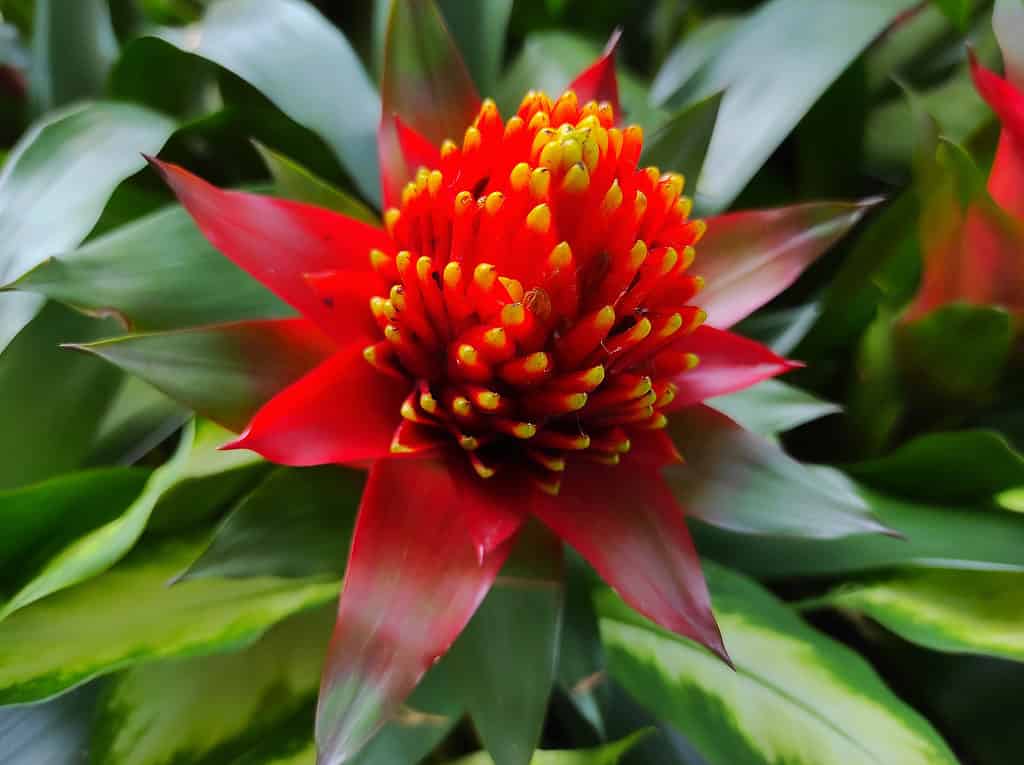
Guzmania is one of the popular flowering varieties of bromeliad for bonsai and houseplants.
©iStock.com/Hanna Yohanna
Some varieties and species of bromeliads have tree-like growth. These are the ones chosen for bonsai training. Others are basically succulents and aerial and don’t work very well for the art form. Most that folks would identify as bromeliads are colorful flowering plants that come in a range of vivid colors, including oranges, yellows, reds, pinks, and purples. They look and feel tropical.
Origins and History of Bromeliad
Bromeliads are native to the tropical regions of the Americas. They were originally cultivated by the Carib tribe in the West Indies. Europeans learned to appreciate them around 1493 and started cultivating them as well, including the delicious pineapple. The only species that natively grows north of the tropics is Spanish moss, the stringy, soft aerial “moss” that grows in locations like Louisiana and Florida, hanging from trees. It’s not actually a moss, but rather an epiphytic bromeliad. This type of bromeliad is often gathered and cultivated for use in household crafting but it would not work as a bonsai.
Growing Habits of Bromeliad
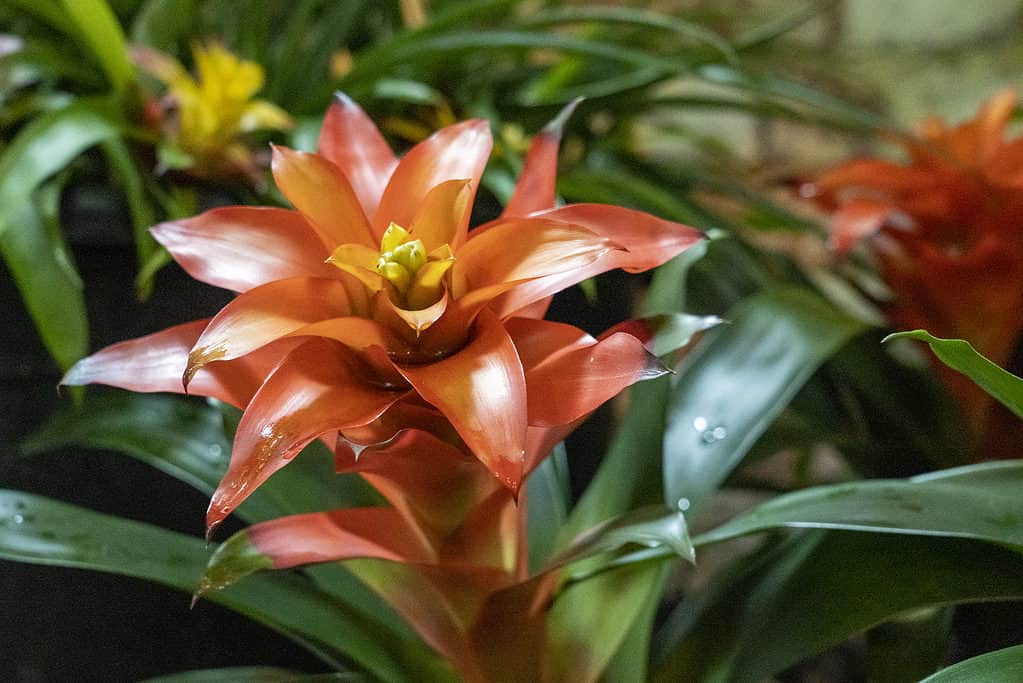
The plant comes in a wide range of colors and styles, with this one the most commonly identified among casual growers.
©iStock.com/Anton Skripachev
Because bromeliads are not your “typical” bonsai plant, we thought a brief chat about the growing habits might be helpful. There are three basic types of growing habit for this family of plants.
Epiphytic
These are the bromeliads that grow as aerial plants and cannot be used as bonsai. This includes the species like Spanish moss. They don’t have trunks or stems and use their unique root systems to “drink in” their needed water from the moisture in the air. They must be kept in fairly high humidity areas or they won’t survive.
Terrestrial
These are the types that can be used as bonsai trees. They grow in soil with more typical stems that can develop into something closer to what we think of as a tree trunk.
Saxicolous
These are the ones we think of most often when we hear the term bromeliad. These are the bromeliads that grow on rocks as succulents.
Popular Varieties of Bromeliad
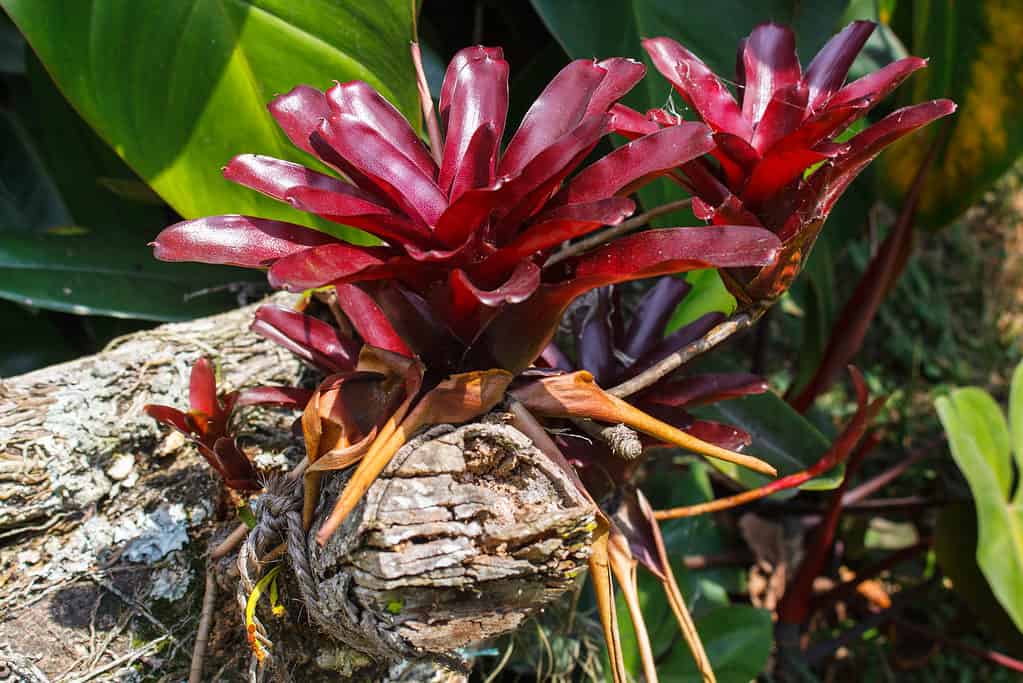
They feed by their leaves rather than a solid root system, meaning they do well as aerial plants.
©iStock.com/mdurajczyk
There are four main varieties of bromeliad that are most popular among folks growing them at home.
Guzmania
This variety is the most common “house plant” variety of bromelia. They’re the bright, colorful ones you’ll spot at nurseries and garden centers in most cases, with vibrant red, yellow, purple, orange, or white flowers. They reach up to 2 feet in height. This variety may be used as bonsai, though will be challenging in this art form.
Vriesea
This variety also has vibrant, bold flower spikes and variegated foliage. They’re reasonably common though not as common as Guzmania.
Ananas Comosus Champaca or Ornamental Pineapple
This plant is an ornamental pineapple plant that produces spidery leaves along with the colorful flower spikes. They’re often used as houseplants but less frequently as bonsai. They may be trained like other bromeliad, however, so may do fine in this role.
This particular species of bromeliad isn’t necessarily as colorful as some other species, but it is one of the most tree-like species and therefore may be your best as a bromeliad bonsai. They develop thicker trunks and may be be more easily trained because of this, though still don’t have traditional “branchy” extensions that we often think of as the shaped portions of bonsai.
Neoregelia
This variety is shorter, staying under 1 foot in height even when left to grow wild. They’re not the wild, showy variety as the others, but they’re still attractive and unique. They have tiny blooms, but their foliage is where the flare is at. For some folks, this actually makes them the better variety, as the color stays present in the foliage for a longer season.
Special Notes on Bromeliad
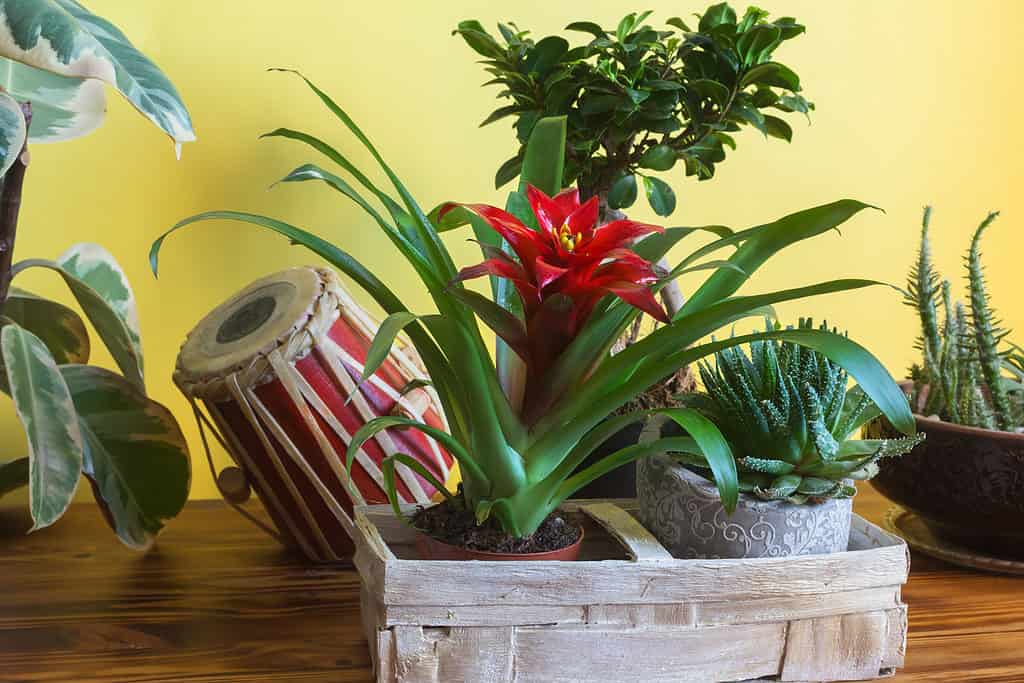
Bromeliad are favored for their unique leaves, the bright flowers, and the colorful foliage in the many varieties.
©iStock.com/Margarita Khamidulina
Bromeliad bonsai trees require some special care, particularly pertaining to their soil needs. They need proper drainage especially as they are exceptionally prone to root rot.
Care Guide for Bromeliad Bonsai
Placement
One of the reasons bromeliads make for excellent bonsai is that they do well in a range of locations and lighting situations. They do, however, require at least partial sun, high humidity, and warm temperatures. This means that when it is cooling off outdoors, they should be brought indoors.
They do well in green houses, grow tents, and bathrooms when kept indoors in cooler months. Be sure they have light wherever they are placed. And if you notice they’re discoloring or fading, add in some LED grow lights.
Lighting
Bromeliad bonsai do well in lighting conditions from full sun to partial shade. However, the plant will change colors if it isn’t receiving enough sun. If you notice the colors are fading and green is coming into play, change the placement or add some grow lights.
Temperature

Most people grow bromeliad simply as “potted plants” – but they may be trained like bonsai.
©iStock.com/Robi_J
Most species of bromeliads commonly used as houseplants and bonsai can handle a range of temperatures. Some can handle cold temperatures near freezing, while others can only tolerate night temperatures down to about 50 degrees F. Some handle temperatures in the low 100-ish degree range. Most thrive in temperatures between 70 and 90-degrees F by day and 50 to 65-degrees F by night.
Watering
Bromeliads survive in a range of growing conditions, however, their water tanks (the cup or center of the blooms) hold water for them, which is part of how they survive for longer times in drier conditions, despite being tropical and semi-tropical plants.
Fill the tank of the bromeliad when you water it. Check the tank daily to ensure it hasn’t gone dry and don’t over water the tank. That is, don’t fill the cup daily unless it is actually dry or near empty. Be sure the pot for your bromeliad has proper drainage or the plant may suffer from root rot.
Bromeliads are sensitive to chemical-laced water, so the best choice will be rainwater. However, if you’re unable to collect rainwater consistently, use distilled water, or at the least, purified water.
Feeding
Bromeliad bonsai need to be fed regularly for their health and for maintenance of the vibrant colors of the plant. Look for indoor plant food fertilizers in liquid form for best results, as these tend to have the best NPK ratio for bromeliads to thrive and keep those vibrant colors growing.
The gentle NPK fertilizer should be given every watering for best results, as well, which also makes keeping them fed easier: no special schedule to memorize.
Pruning, Shaping, and Wiring
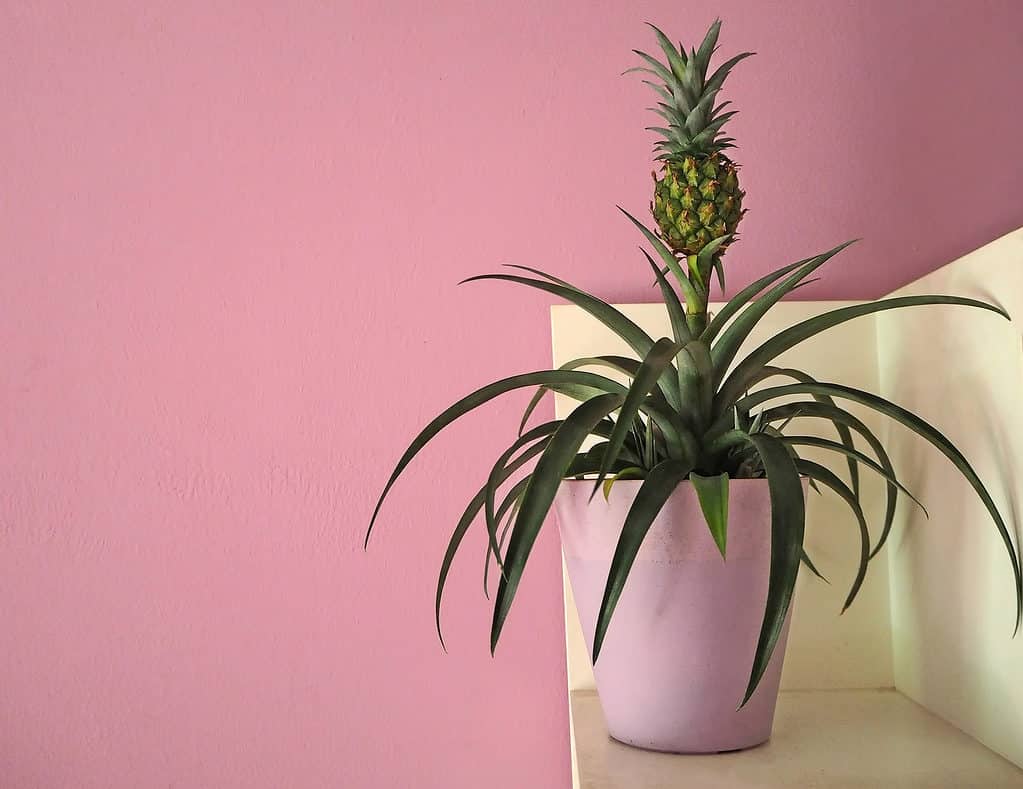
One particularly familiar species of bromeliad is the pineapple.
©iStock.com/Luca Piccini Basile
Bromeliad bonsai are less trainable than other species of bonsai because of the nature of the plant. “Training” for them is going to be more about basic pruning, shaping, and placement than traditional bonsai shaping. Trim and prune as needed but focus more on keeping them healthy and colorful than shaping as traditional bonsai.
Gentle wiring with aluminum wire may be possible with bromeliad bonsai, but they’ll need to be shaped early in life and maintained gently. This is particularly the case with this variety of bonsai because the plants only live three to four years, in most cases, and only bloom once in their lifetime (usually for months per bloom).
Wiring and shaping must be done before the flowering begins, else you will lose the bloom or stunt its growth.
Re-potting
Bromeliad bonsai will require re-potting frequently when the plant is young. Use the commercially available bonsai soil for the plant whenever you re-pot, cleaning the roots and trimming back as needed when you re-pot. Make sure that when you re-pot, the soil doesn’t become compacted, but is loose and has plenty of drainage capability. Some folks mix in small pebbles or gravel to provide additional space without air bubbles in the soil.
Common Problems of Bromeliad
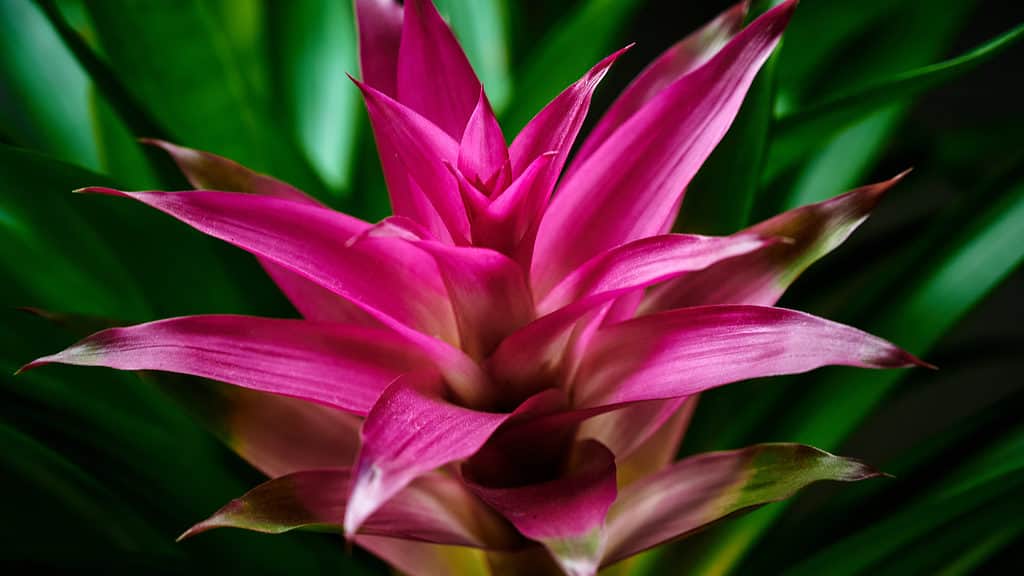
Bromeliad only bloom once in their short lifetime, but the blooms last for months.
©iStock.com/Dagmar Niemann
As with most varieties of bonsai, bromeliad are susceptible to root rot due to over watering. Many enthusiasts with less experience may be overzealous with watering, resulting in this issue. Cut back on watering if you notice the plant wilting, melting, or “getting soft” as these are signs the bromeliad bonsai probably is receiving too much water.
Certain varieties (like pineapples) are also susceptible to insect invasion, including ants, mealy bugs, spider mites, and scale. Regularly inspect your bromeliad bonsai monthly for signs of these insects, including under the leaves. If you notice any signs of nibbling, hard “scales” or bumps on the foliage or flowers, webs, or other insect activity, find a gentle insecticide soap and dilute it highly before washing the leaves gently with the soap. Rinse in fresh distilled water or rainwater.
How to Propagate Bromeliad

Bromeliad come in a wide range of colors from white to yellow to deep purple and red.
©iStock.com/raksyBH
Bromeliad bonsai aren’t as popular with some enthusiasts as other species because they’re not as long-living as a hemlock or fir, for example. They typically only live three to four years. They do, however, procreate fairly frequently, providing you with beautiful bromeliad progeny via offsets or pups.
When the pups are about half the size of the mother plant, they will start forming roots. They may be cut away from the parent at this point and potted separately as a separate plant.
Fun Facts and Tidbits about Bromeliad Bonsai

Bromeliad are often planted together in a single box, creating multi-forms of bonsai.
©iStock.com/ASIMAKIN
Bromeliad are a fascinating plant genus with many intriguing and fun facts.
- There are two bromeliads you’re probably already quite familiar with that don’t have those fancy spiked flowers: pineapple (yes, the fruit) and Spanish moss, the wispy “moss” that hangs from Live Oaks in the southern states. The pineapple makes for a good bonsai, while, for obvious reasons, Spanish moss doesn’t. The mix of varieties in growth patterns and forms among bromeliad means that many won’t work as bonsai, but specific ones will make for unique and intriguing bonsai.
- Blooms on bromeliads last for a long time, often for months at a time.
- Many species of bromeliad plants only bloom once, though. That’s why pineapple trees only produce a single fruit before passing along to plant heaven.
- Bromeliad plants are year-round plants. They thrive in all seasons, as long as they don’t get too cold and receive proper care.
- Bromeliad are particularly susceptible to over watering is one of the biggest reasons some folks struggle to keep them alive.
- Bromeliad bonsai are usually pest-free, which makes them one of the best plants for folks to grow as bonsai, if they’re willing to care for them as directed (i.e., avoiding that over watering issue!).
- Bromeliads don’t eat via their roots but rather get most of their nutrients through their leaves. This is why liquid fertilizer is best and why they grow so well among rocks and as aerial plants.
Up Next:
Thank you for reading! Have some feedback for us? Contact the AZ Animals editorial team.








